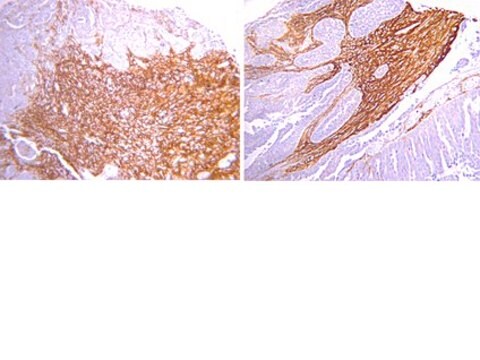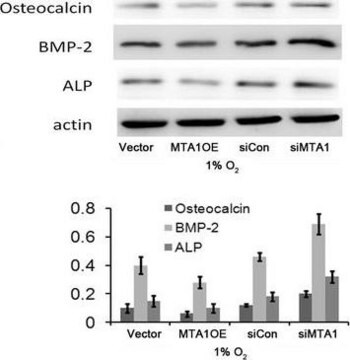AB1870
Anti-Osteopontin Antibody
serum, Chemicon®
Sinonimo/i:
Uropontin, Bone sialoprotein 1, SPP1/CALPHA1 fusion, Urinary stone protein, bone sialoprotein I, osteopontin/immunoglobulin alpha 1 heavy chain constant region fusion protein, secreted phosphoprotein 1, secreted phosphoprotein 1 (osteopontin, bone sialop
Scegli un formato
CHF 577.00
Spedizione prevista il21 maggio 2025
Scegli un formato
About This Item
CHF 577.00
Spedizione prevista il21 maggio 2025
Prodotti consigliati
Origine biologica
rabbit
Livello qualitativo
Forma dell’anticorpo
serum
Tipo di anticorpo
primary antibodies
Clone
polyclonal
Reattività contro le specie
mouse, rat, human
Produttore/marchio commerciale
Chemicon®
tecniche
ELISA: suitable
immunohistochemistry (formalin-fixed, paraffin-embedded sections): suitable
western blot: suitable
N° accesso NCBI
N° accesso UniProt
Condizioni di spedizione
dry ice
modifica post-traduzionali bersaglio
unmodified
Informazioni sul gene
human ... SPP1(6696)
Descrizione generale
Specificità
Immunogeno
Applicazioni
A previous lot of this antibodu was used at a 1:1500 dilution on paraffin-embedded tissue sections.
ELISA:
A previous lot of this antibody was used at a 1:1000 dilution.
Optimal working dilutions must be determined by end user.
Cell Structure
Osteobiology
Qualità
Western Blot Analysis: 1:500 dilution of this lot detected osteopontin on 10 μg of RAW 264.7 lysates.
Descrizione del bersaglio
Stato fisico
Stoccaggio e stabilità
Handling Recommendations:
Upon first thaw, and prior to removing the cap, centrifuge the vial and gently mix the solution. Aliquot into microcentrifuge tubes and store at -20°C. Avoid repeated freeze/thaw cycles, which may damage IgG and affect product performance.
Risultati analitici
POSITIVE CONTROL: Human urine (2-5 µg/mL normal concentration).
Altre note
Note legali
Esclusione di responsabilità
Non trovi il prodotto giusto?
Prova il nostro Motore di ricerca dei prodotti.
Codice della classe di stoccaggio
10 - Combustible liquids
Classe di pericolosità dell'acqua (WGK)
WGK 1
Punto d’infiammabilità (°F)
Not applicable
Punto d’infiammabilità (°C)
Not applicable
Certificati d'analisi (COA)
Cerca il Certificati d'analisi (COA) digitando il numero di lotto/batch corrispondente. I numeri di lotto o di batch sono stampati sull'etichetta dei prodotti dopo la parola ‘Lotto’ o ‘Batch’.
Possiedi già questo prodotto?
I documenti relativi ai prodotti acquistati recentemente sono disponibili nell’Archivio dei documenti.
Active Filters
Il team dei nostri ricercatori vanta grande esperienza in tutte le aree della ricerca quali Life Science, scienza dei materiali, sintesi chimica, cromatografia, discipline analitiche, ecc..
Contatta l'Assistenza Tecnica.







